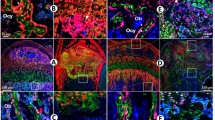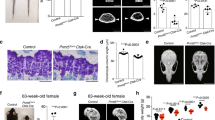Abstract
Mammalian bones have three distinct origins (paraxial mesoderm, lateral plate mesoderm, and neural crest) and undergo two different modes of formation (intra-membranous and endochondral). Bones derived from the paraxial mesoderm and lateral plate mesoderm mainly form through the endochondral process. During this process, hypertrophic chondrocytes play a vital role in inducing both osteogenesis and angiogenesis. One of the essential osteogenic factors secreted from hypertrophic chondrocytes is Indian hedgehog (Ihh). In contrast, bones derived from the neural crest mainly form through the intramembranous pro-cess and do not require Ihh. Thus, depending on their origin, bones have distinct signaling properties, which need to be considered in the research and application of bone biology.
Similar content being viewed by others
Author information
Authors and Affiliations
Additional information
Presented at the 18th Annual Research Meeting of the Japanese Orthopaedic Association, Kitakyushu, Japan, October 17, 2003
About this article
Cite this article
Chung, Ui., Kawaguchi, H., Takato, T. et al. Distinct osteogenic mechanisms of bones of distinct origins. J Orthop Sci 9, 410–414 (2004). https://doi.org/10.1007/s00776-004-0786-3
Received:
Accepted:
Issue Date:
DOI: https://doi.org/10.1007/s00776-004-0786-3




